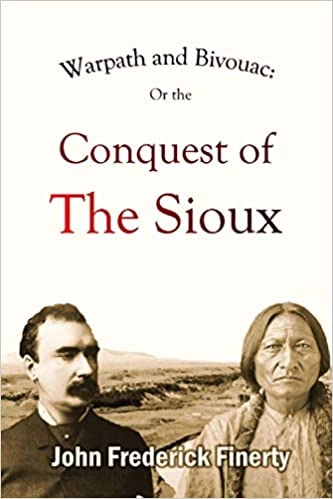Reading Level
What is the reading level of Warpath and Bivouac: Or the Conquest of The Sioux ?
Analysing the books in the series, we estimate that the reading level of Warpath and Bivouac: Or the Conquest of The Sioux is 9th and 10th grade.
Expert Readability Tests for
Warpath and Bivouac: Or the Conquest of The Sioux
| Readability Test | Reading Level |
|---|---|
| Flesch Kincaid Scale | Grade 9 |
| SMOG Index | Grade 11 |
| Coleman Liau Index | Grade 9 |
| Dale Chall Readability Score | Grade 6 |
Reading Time
6 hrs 35 mins
How long to read Warpath and Bivouac: Or the Conquest of The Sioux (1890)?
The estimated word count of Warpath and Bivouac: Or the Conquest of The Sioux (1890) is 98,580 words.
A person reading at the average speed of 250 words/min, will finish the book in 6 hrs 35 mins. At a slower speed of 150 words/min, they will finish it in 10 hrs 58 mins. At a faster speed of 450 words/min, they will finish it in 3 hrs 40 mins.
| Warpath and Bivouac: Or the Conquest of The Sioux (1890) - 98,580 words | ||
|---|---|---|
| Reading Speed | Time to Read | |
| Slow | 150 words/min | 10 hrs 58 mins |
| Average | 250 words/min | 6 hrs 35 mins |
| Fast | 450 words/min | 3 hrs 40 mins |
- Authors
-
John Frederick Finerty
More about Warpath and Bivouac: Or the Conquest of The Sioux
98,580 words
Word Count
for Warpath and Bivouac: Or the Conquest of The Sioux (1890)
287 pages
Pages
10 hours and 36 minutes
Audiobook length
Description
"A very spirited narrative of Indian warfare." - The Atlantic, 1892"One of the best of all the books written upon the Indian troubles." -Magazine of Western History, 1890"One of the most interesting and best written stories." -Life and Adventures of Frank Grouard, Chief of Scouts (1891)"Some of the fiercest and bloodiest fighting ever done on our frontier, graphically told, narrated by one of the active participants." -N. Y. Independent, 1891.Christened "The Fighting Correspondent,” by famous scout Frank Grouard, John Finerty, serving as field correspondent of the Chicago Times, would on more than one occasion narrowly escape massacre in the four Indian wars he covered, including the campaign against Sitting Bull in 1876, and the famous Sibley scouting expedition in the Big Horn mountains.As Finerty details in his 1890 book "Warpath and Bivouac," he endeared himself alike to the officers and men of Crook’s command, and shared all their dangers and deprivations. The journalistic profession has just cause for pride over the conspicuous bravery that characterized this “fighting correspondent.” According to Scout Frank Grouard, Finerty importuned him to be permitted to accompany him on every scouting expedition that was organized, but not until the starting of the Sibley party did the correspondent have his wishes gratified. When Finerty asked to accompany the Sibley party, General Crooke warned him that he "might get into more trouble than, perhaps, I anticipated." Lieutenant Bourke the asked him "what kind of an epitaph I would like him to write for me." It turned out these warnings should have been heeded, as Finerty would find out:"Groups of mounted savages appeared on the bluffs north and east of us. Most of them were in full war costume.... My horse stumbled from the shock of the bullet, but recovered its feet almost immediately, and bore me in safety to the edge of the timber, under the rapid Indian fire. I could hear their bullets rattling against the pine tree trunks like hail-stones on the roof of a barn. "We could distinctly hear their savage, encouraging yells to each other, and Gruard said that Sioux and Cheyennes were allied in the attacking force, all of whom appeared to be in great glee at the prospect of a scalping entertainment.…"In describing his arranged meeting with Sitting Bull, Finerty noted that "I have followed Sitting Bull around long enough, and now I shall behold, 'the lion in his den,' in earnest...."Soon afterward, an Indian mounted on a cream-colored pony, and holding in his hand an eagle's wing, which did duty for a fan, spurred in back of the chiefs and stared stolidly, for a minute or so, at me. His hair, parted in the ordinary Sioux fashion, was without a plume. His broad face, with a prominent hooked nose and wide jaws, was destitute of paint. His fierce, half bloodshot eyes gleamed from under brows which displayed large perceptive organs, and, as he sat there on his horse, regarding me with a look which seemed blended of curiosity and insolence..."About the author: John Frederick Finerty (1846 –1908) was a U.S. Representative from Illinois. Born in Ireland, Finerty immigrated to the United States in 1864. He enlisted in the Union Army during the Civil War serving in the New York State Militia. He was a war correspondent for the Chicago Times in the Sioux War of 1876, in the Northern Indian (Sioux) War of 1879, in the Ute campaign of 1879, and afterward in the Apache campaign of 1881. He was a correspondent in Washington, D.C. during 1879–1881. He established the Citizen, a weekly newspaper, in Chicago in 1882.
